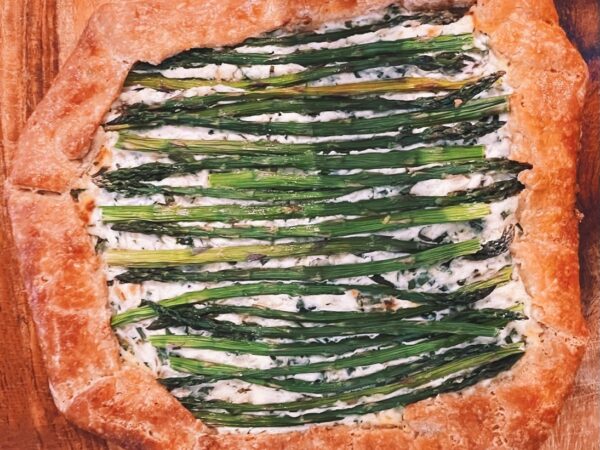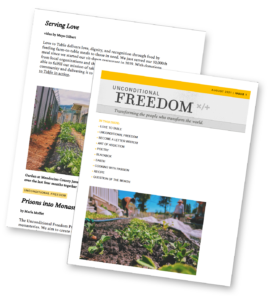by Louise Ayer
We had a lot of fun developing this Spring Galette recipe. We looked up a ton of recipes to see the general technique before landing on an approach that fits with our style of cooking. I have the uncanny ability that when I read a recipe, I can taste its results. As I read different recipes, I can tell if the proportions are off or if it is missing something, unless it is a cuisine that I am not familiar with. In that case, I have to follow the recipe to see what it is all about.
With an asparagus tart, people use different kinds of cheese — goat cheese, parmesan, mozzarella, mascarpone — with egg, without egg, or crème fraîche in different combinations. Some flavor the mixture with different kinds of herbs and some just rely on the cheese’s flavor. Lots of people use puff pastry as the base, but I love galette dough because of its flexibility and texture. We made up a couple of different tarts and had a tasting party. Galette dough is very forgiving and makes an absolutely delicious crust. Each taster raved about the galette’s texture and flavor.
We all loved the recipe that follows the best, hands down. I hope you will agree.
Crust
Ingredients*:
⅔ cup all-purpose flour
⅓ cup sprouted spelt flour
¼ cup cornmeal
3 tablespoons yogurt
⅓ cup ice water
1 teaspoon sugar
½ teaspoon salt
7 tablespoons cold, unsalted butter, cut into small chunks
*We prefer to use all organic ingredients.
To make the dough by hand:
When I was younger, I would only have made this by hand, but now that I am almost 75, I appreciate a food processor’s help. I will give instructions on both methods so that you can choose the approach which suits you best.
In a small bowl, mix the yogurt into the ice water and put it in the freezer for 10 or 15 minutes. In a large bowl, mix together the three flours, sugar, and salt with a fork until well combined. Drop in the chunks of butter and toss them until they are covered with flour. With a pastry blender, sharp knife, or — my favorite — fingertips, work the butter into flour until the dough ranges in size from small peas to bread crumbs. The small pieces make the dough tender. The larger pieces make the dough flaky. Sprinkle the ice water/yogurt over the flour, one tablespoon at a time while tossing the forming dough with a fork. You want enough liquid so that the dough holds together when pressed, but no more as you do not want to overwork the dough or melt the butter.
Turn the dough out onto a lightly floured surface and form it into a disc. Wrap the disc in plastic wrap or wax paper and refrigerate it for at least 2 hours.
To make the dough in a food processor:
In a small bowl, mix the yogurt into ice water and put it in the freezer for 10 or 15 minutes. Put a metal blade on the food processor. In the food processor’s bowl, add the three flours, sugar, and salt and pulse 2 or 3 times to combine. Add the chunks of butter and pulse the mixture about 10 times, until the dough ranges in size from small peas to bread crumbs.
All of the instructions for making pie crust in a food processor tell you at this point, with the machine running, add the yogurt/ice water mixture and process until the dough starts to clump together. That said, I prefer to add a tablespoon of the yogurt/ice water at a time, pulsing after each addition until the dough starts to clump together. This adjustment creates a subtle difference, but I feel it gives me a little more control and prevents me from overwatering the dough if it does not quite need all of the water.
Turn the dough out onto a lightly floured surface and form it into a disc. Wrap the disc in plastic wrap or wax paper and refrigerate it for at least 2 hours. (You can also roll the dough into a larger 12” circle instead of a disc and freeze it to save a step later on.)
The dough can be kept in the fridge for a day or two, or you can wrap it airtight and store it in the freezer for up to a month. To thaw, place the still wrapped dough in the fridge for a day or so.
Filling
Ingredients:
1 cup goat cheese at room temperature (4 or 5 ounces)
1 large egg at room temperature, slightly beaten
1 large clove garlic, minced
2 tablespoons fresh chives, minced
1 ½ tablespoons chopped fresh tarragon leaves, or 1 ½ teaspoons dried leaves
1 tablespoon lemon zest
½ teaspoon sea salt, plus more for sprinkling
¼ teaspoon freshly grated nutmeg
1 cup crème fraîche at room temperature
½ tablespoon minced parsley
1 teaspoon dried lemon or regular thyme
Freshly ground black pepper, to taste
2 tablespoons grated parmesan
1 tablespoon plus 1 teaspoon extra virgin olive oil
1 ½ ounces shaved parmesan (with a vegetable peeler), about ½ cup
8 ounces thin asparagus, woody ends trimmed off, and each piece cut in half
In a medium bowl, whisk together all of the ingredients listed above except for the shaved parmesan, tablespoon of olive oil, and asparagus (all of the first 13 ingredients and 1 teaspoon olive oil).
Preheat oven to 400 F. Line a baking sheet with parchment paper. On a well-floured surface, roll out the dough into approximately a 12” circle. Trim the edges. Transfer the dough to the baking sheet. Fold the dough to make a 2” border all around. Spread the cheese mixture evenly over the dough up to the border. Arrange the asparagus halves over the dough.
Glaze
1 egg
1 tablespoon water
Beat the egg in a small bowl and add in the water. Brush the crust border with the glaze.
Bake the galette for 30 minutes until the crust is golden brown. Let the galette cool and set for at least 10 minutes before dividing and serving. You can serve the galette warm or let it cool to room temperature.

 Get access to the monthly Rehumanization Magazine featuring contributors from the front lines of this effort—those living on Death Row, residents of the largest women’s prison in the world, renowned ecologists, the food insecure, and veteran correctional officers alike.
Get access to the monthly Rehumanization Magazine featuring contributors from the front lines of this effort—those living on Death Row, residents of the largest women’s prison in the world, renowned ecologists, the food insecure, and veteran correctional officers alike.